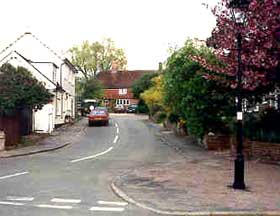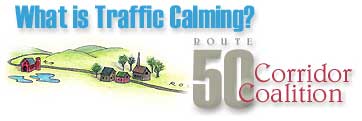An Introduction to Traffic Calming Insight into the concept of Traffic Calming, its objectives and benefits. Traffic calming is a combination of physical measures and a supportive environment that reduces the negative effects of motor vehicle use on individuals and society in general. This is accomplished by changing the design and role of streets to serve a broad range of transportation, social, and environmental goals and objectives. Typical measures are raised intersections, landscaped medians, small traffic circles,  use of paving stones or cobblestones, walkways, and entrance features to towns. use of paving stones or cobblestones, walkways, and entrance features to towns. Traffic Calming has become a conventional practice in Europe. Measures blend in well and become an attractive part of the streetscape These design changes not only beautify and enhance the community, but greatly increase safety for motorists and pedestrians alike. Collisions are known to decrease greatly in traffic calmed areas and severe injuries can be decreased by as much as 80 percent. To sum up, traffic calming is intended to achieve slower, safer speeds for motor vehicles and require drivers to observe speed limits so as to: - Reduce collision frequency and severity
- Improve the real and perceived safety for non-motorized users of the street
- Reduce the need for police enforcement
- Provide more greenery (trees, shrubs, etc.)
- Increase access to land for all modes of transportation, and
- Reduce cut-through motorized vehicle traffic.
For additional discussion with respect to safety improvements resulting from traffic calming, see Safety, Safety, Safety. “The majority of speeding is done by normally responsible drivers who find themselves "invited" to speed by the road's design features, such as excessively wide pavement, straight sections of road and absence of vegetation.” Walter Kulash - Traffic Calming: An Overview; STPP Progress, July 1996. The History of Traffic Calming In the late 1960’s, residents of Delft, The Netherlands, became so angry with motorists cutting through their neighborhood at high speeds that they went into the street at night and took up the paving stones in a serpentine pattern. This allowed motorists to pass but at greatly reduced speed. Officials allowed the redesigned road to remain and the first traffic calming project was born. German planners adopted the concept in the 1970’s, and by the end of the decade, traffic calming became a widely accepted and successful transportation policy. Traffic calming spread quickly throughout Europe and to many other countries including Denmark, Switzerland, Great Britain, Canada, Japan, Australia, New Zealand, and the United States. Traffic Calming in Rural Communities Many rural communities, towns, and villages grew up around a main street like Route 50. The main street was typically part of the through highway and it provided access to the communities’ businesses, public buildings, and institutions, as well as many homes. Since World War II, motorized vehicle traffic has increased and now dominates the main streets. A predominantly single-function main street emerged, with street design and driver behavior creating a barrier between traffic and the community. In the 1970s, Danish road authorities recognized that the quality of life expected in rural communities was being eroded by motorized traffic, and that the community functions were in conflict with, and losing to, the traffic functions. The Danes decided to conduct bold experiments using three rural communities, and built what they called “environmentally adapted through roads”. These early traffic calming experiments were a huge success, resulting in improved business, aesthetics, and environment, a reduction in the frequency and severity of collisions, and increased pedestrian activity. Studies showed that the majority of local people, as well as drivers passing through the communities, supported the changes. Traffic calming subsequently was implemented in hundreds of rural communities throughout Denmark. The solution spread to rural communities in other countries as well, including Belgium, The Netherlands, France, Austria, Germany, and Switzerland. Traffic Calming on Rural Route 50 The concerns of the citizens in the Route 50 corridor are remarkably similar to those expressed in professional literature and by European transportation experts. The speed of the traffic, the poor pedestrian environment, issues regarding government expenditures on highway infrastructure, local business vitality, safe school routes, are all echoes of the same dilemma. The populations, traffic volumes, and distances involved in many of the European applications were similar to or greater than those on Route 50. “As a plan proposed and developed by grassroots organizations and citizens, the Route 50 traffic calming project represents the true spirit of community, placing government in the hands of the people and allowing them to participate in determining the future of their community” Experience shows that traffic calming will be highly effective in a rural setting like the Route 50 corridor. It is particularly appropriate because of the historical and scenic setting and the imminent threats to the area. This rural traffic calming plan is unique in the United States and therefore will be an important pilot project for the country. Return to top of page |

